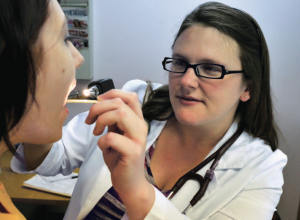 By Ashley Singh Thomas
By Ashley Singh Thomas
As a child, becoming a physician was not a likely career choice for Crystal Hickman, M.D. In fact, obtaining her college degree was an unprecedented achievement in her family. Now, Hickman is the medical director at the Camden-on-Gauley Medical Center near Webster Springs. She credits her time in high school as part of the Health Sciences Technology Academy (HSTA) as a major contributor to her success.
“HSTA made it possible for me to become a doctor,” says Hickman. “When you don’t have family members who have been to college, you don’t know what classes to take or how to get financial aid for college. The academy helps you with the whole process. Without them, I doubt I would be in this field. Before HSTA, I don’t remember a career in medicine occurring to me.”
HSTA, a program for underserved and financially disadvantaged high school students, promotes the study of science and math. High school students take part in weekly club meetings where they receive guidance from HSTA-trained teachers regarding research and community-based projects. In addition to taking part in these projects during the school year, HSTA students also participate in at least two summer camps where they learn about cutting-edge science and discover the tools they need to help their communities.
“HSTA is built in such a way that it connects children with their communities,” says Ann Chester, Ph.D., HSTA founder and West Virginia University associate vice president for education partnerships. “At a young age, they make a real difference and see how important it is to give back to their community.”
Through HSTA, students learn about the many possible career choices in the health sciences field. The program’s mission is to improve health care through education. HSTA offers tuition waivers for any state-supported university from undergraduate through medical, dental, nursing or pharmacy school. With money out of the equation, HSTA leaders say students are able to focus on their potential instead.
“Students will rise to where the bar is set for them, and so often the bar is set much too low,” says Chester. “You pick kids with potential who wouldn’t ordinarily go to college, and then you show them they can do it.”
Over the past 18 years that HSTA has been in existence, around 1,700 students in 26 counties across the state have graduated from this program. HSTA boasts incredible statistics: 100 percent of HSTA students have graduated from high school, and 96 percent have gone on to college. Additionally, 91 percent of these students remain local and use their talents to give back to their communities. This latter statistic demonstrates HSTA’s value not only to students and their families but also to the state as a whole. West Virginia is known to be medically underserved, and by retaining former students in rural communities, these students help make a strong impact.
“We’ve grown our own health care providers, and that’s what HSTA is about,” says Cathy Morton McSwain, M.S.Ed., assistant director of HSTA. “The kids have come back home, and they realize the importance of working in the hospital and keeping their community healthy.”
HSTA continues to grow its reach as well as its resources. The program recently joined the West Virginia Clinical and Translational Science Institute (WVCTSI), which will allow HSTA more access to researchers and scientists.
“We are providing support for HSTA because our missions align,” says Uma Sundaram, M.D., the founding director of WVCTSI. “Improving health care and addressing health disparities in West Virginia is what we aim to accomplish. Through HSTA, we can continue to grow our own clinician scientists. These children grow up with an understanding of what matters to their communities, and, therefore, they are fully invested in shaping the future of health care in our state.”
Emphasis on math and science is not HSTA’s sole focus. This is a program that encourages students to be their best as well-rounded individuals. It helps them develop confidence, character and courage despite the hardships many of these students have faced in their past.
“Through HSTA, I learned how to research, carefully plan, outline and effectively present a PowerPoint presentation,” says Matthew White, a recent HSTA graduate who is currently attending Marshall University. “I’ve learned how to speak smoothly and comfortably in front of people. Rich or poor, white or black—for once those things didn’t matter because our mentors and individual teachers looked at us all with an equal respect. That feeling you get when you can go experience the health and science field, knowing you’re not judged, is utopian.”
For more information about HSTA, visit www.wv-hsta.org. To learn more about WVCTSI, visit http://wvctsi.org.
About the Author
 Ashley Singh Thomas heads up communications at the West Virginia Clinical and Translational Science Institute. Prior to joining the research institute, Thomas, a University of Virginia graduate, spent several years in the news industry as an award-winning television reporter. You can reach Thomas at wvctsi@hsc.wvu.edu.
Ashley Singh Thomas heads up communications at the West Virginia Clinical and Translational Science Institute. Prior to joining the research institute, Thomas, a University of Virginia graduate, spent several years in the news industry as an award-winning television reporter. You can reach Thomas at wvctsi@hsc.wvu.edu.









